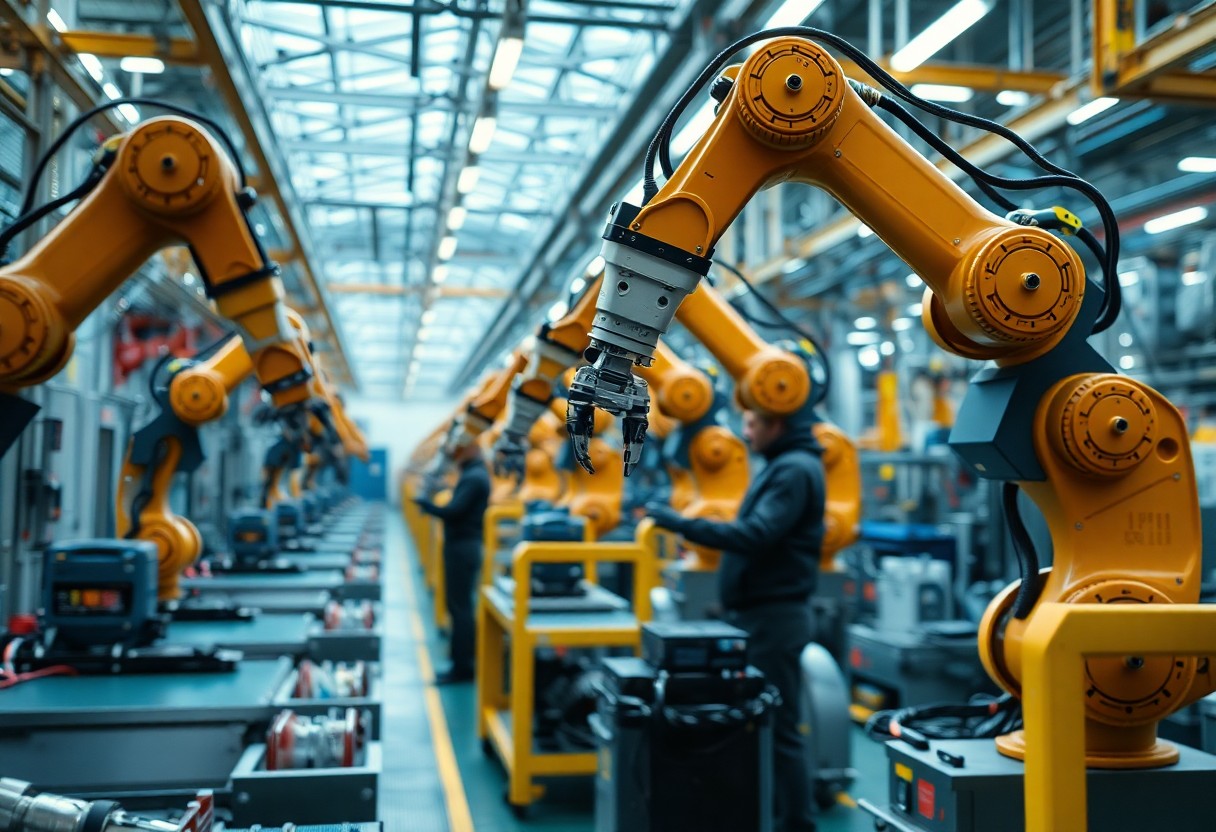It’s imperative to understand how AI automation can streamline your processes and enhance productivity in your business. As you navigate the complexities of modern operations, integrating artificial intelligence can simplify tasks, reduce costs, and improve efficiency. This blog post will explore the ways AI automation serves as a foundational element in achieving not only operational simplicity but also significant profitability in your endeavors. By tapping into these innovative technologies, you can position your business for sustainable growth in an increasingly competitive landscape.
The Economic Rationale for AI Automation
Implementing AI automation has become a vital strategy for achieving economic efficiency in various industries. By harnessing the power of AI, organizations can streamline operations, reduce operational costs, and optimize processes. This shift not only enhances productivity but also enables businesses to respond swiftly to market changes, ultimately leading to a more resilient economic structure. An analysis of the cost-benefit outcome reveals how AI promotes sustainable growth while minimizing waste and inefficiencies.
Cost Efficiency and Resource Allocation
AI automation significantly contributes to cost efficiency by reallocating resources to high-value tasks. By automating repetitive and mundane operations, businesses can save on labor costs and reassign your workforce to more strategic roles that demand creativity and critical thinking. This results in a leaner operational model where resources are employed judiciously, leading to increased profitability and enhanced performance metrics.
The Impact on Labor Markets
The introduction of AI automation has palpable effects on labor markets, with both positive and negative implications. While some jobs may become obsolete as machines take over repetitive tasks, new opportunities emerge in areas requiring advanced skills, such as AI management and development. Workers are provided the chance to upskill or reskill to stay competitive in the evolving job landscape, making adaptability paramount in this new economic reality.
The evolving landscape requires a proactive approach to ensure smooth transitions for workers affected by automation. For instance, upskilling initiatives have gained traction in numerous industries, with companies investing in training programs to help employees acquire the necessary expertise in AI and technology management. This not only eases the transition but also empowers your team to harness AI tools effectively, creating a workforce that thrives alongside automation rather than being displaced by it. Successful case studies, such as Amazon’s retraining efforts for its workforce, illustrate the potential for a synergistic relationship between workers and automated systems, driving greater innovation and efficiency in the long run.

Simplifying Complex Processes: AI in Action
AI technology holds transformative power in simplifying intricate processes that burden many businesses. By leveraging machine learning algorithms and advanced data analytics, AI can optimize workflows, reduce redundancies, and automate routine tasks. For instance, in sectors like logistics and manufacturing, AI-driven systems can anticipate demand fluctuations, streamline inventory management, and coordinate supply chains with unparalleled precision. This not only enhances operational efficiency but also shifts your focus from handling complexity to strategic decision-making, ultimately fostering a more dynamic and responsive business environment.
Streamlining Operations Across Industries
Across various sectors, the infusion of AI into operations has resulted in notable improvements in speed and efficiency. For example, in healthcare, AI algorithms assist in diagnostics, offering faster and more accurate results than traditional methods, thereby enabling healthcare professionals to focus on patient care rather than administrative bottlenecks. Similarly, within the finance sector, AI automates transactions and compliance checks, ensuring quick responses to market movements and regulatory requirements. Streamlining operations with AI isn’t just a trend; it usher’s in a new standard of productivity that businesses need to adopt to remain competitive.
Real-Time Decision Making and Adaptive Systems
Integrating AI into your operations empowers real-time decision-making and creates adaptive systems that respond instantly to market changes. For instance, retail giants use AI to analyze customer behavior as it happens, enabling personalized marketing strategies and agile inventory management. By continuously adjusting to consumer demands, your business can enhance the customer experience while minimizing wastage and stock shortages. AI not only processes vast amounts of data promptly but also learns from past interactions, facilitating continuous improvement in decision-making processes.
Understanding how real-time decision-making works involves considering how AI systems analyze data streams continuously to provide actionable insights. Take the example of a smart manufacturing facility that employs AI to monitor equipment performance in real-time. If a machine shows signs of potential failure, the AI system can immediately alert staff while simultaneously adjusting production schedules to minimize downtime. This proactive approach not only saves costs but also ensures your operations run smoothly, maintaining high service levels and optimizing resource use. The adaptability of systems powered by AI allows you to pivot swiftly in response to changing conditions, ensuring your business remains ahead in a fast-paced environment.

The Intersection of AI and Human Creativity
Innovations in AI are not just tools; they are catalysts that amplify human creativity. By harnessing machine learning and data analytics, you can uncover insights that inspire new ideas, streamline project workflows, and create compelling narratives that resonate with your audience. Think of AI as an assistant that fuels your creative process, allowing you to focus on the broader vision while it manages data-driven tasks and repetitive elements. This synergy between AI and human ingenuity paves the way for unexpected breakthroughs in art, design, writing, and other creative sectors.
Enhancing Productivity Without Replacing Talent
Productivity thrives when AI supports your existing talent rather than replaces it. AI technologies enable you to automate mundane tasks, freeing up time for you and your team to concentrate on higher-order thinking and innovation. This approach not only enhances efficiency but also fosters a culture where your unique contributions are valued, ultimately leading to superior outcomes and a more engaged workforce.
Collaborative AI: The Role of Human-AI Partnerships
Human-AI partnerships redefine how you approach problem-solving and creativity. When AI systems are designed to complement human skills, they create a dynamic interaction that enhances your capabilities. For instance, in industries like music and design, AI-generated suggestions can serve as creative springboards, leading to unique collaborations that may not have emerged otherwise.
Imagine using AI tools for brainstorming sessions. These systems can analyze trends and generate ideas instantaneously, empowering you to build upon their suggestions. In marketing, for example, AI algorithms can assess consumer behavior and recommend targeted content strategies. By embracing collaboration with AI, you effectively expand your creative horizons, allowing for innovation that leverages both technological aptitude and human insight. Companies like Adobe have integrated AI features in their Creative Cloud Suite, helping users elevate their work by offering contextual suggestions, thus demonstrating how collaborations can yield extraordinary results.

Overcoming Barriers: Common Misconceptions About AI Automation
Many misconceptions surrounding AI automation persist, often stemming from a lack of understanding or fear of change. For instance, some believe AI will completely replace human workers, while others think it’s only accessible to large corporations. In reality, AI is a tool that enhances productivity and can be tailored to fit businesses of all sizes. Educating yourself about the versatility and accessibility of AI can alleviate these misconceptions, making it easier to embrace the technology and leverage its benefits for streamlining operations and boosting profitability.
Addressing the Fear Factor: Job Loss vs. Job Transformation
The fear of job loss due to AI automation is common, but the focus should shift towards job transformation. While some roles may evolve or disappear, new opportunities arise as businesses adapt to technology. Tasks that are repetitive or dangerous can be automated, allowing you to engage in more strategic, fulfilling work. Witnessing this shift can empower employees, who now have the chance to enhance their skill sets and assume roles that require more creativity and decision-making.
Transparency and Trust in Automated Systems
Trusting AI systems begins with transparency. You want to understand how algorithms make decisions and the factors influencing those decisions. Companies implementing AI need to clearly communicate the processes behind their systems and how they safeguard data integrity. By sharing insights into the training data, algorithm choices, and outcomes, businesses can cultivate trust among users. When you see how AI operates and the rationale behind it, adopting these technologies becomes less daunting, ultimately leading to a smoother integration of automation into your workflows.
Establishing transparency also involves open dialogues about data usage and ethical considerations. Initiatives like regular reporting and user feedback loops can further enhance trust. For instance, organizations like Google and Microsoft have committed to ethical AI guidelines, demonstrating their dedication to responsible automation. As you engage with these systems, understanding their workings not only diminishes anxiety but fosters a collaborative ecosystem where technology complements human intelligence, promoting innovation and enhancing your business processes.
Future-Proofing Your Business with AI Strategies
In an era of rapid technological evolution, integrating AI strategies into your business plan has become crucial for sustainability. Embracing AI not only enhances efficiency but also equips you with insights that anticipate market shifts. By proactively implementing AI solutions, your organization can navigate uncertainties, streamline operations, and ultimately bolster profitability.
Leveraging Data for Continued Growth
Your business’s ability to adapt and thrive hinges on making informed decisions backed by data. Effectively leveraging the vast amounts of data generated can reveal valuable trends and customer preferences, enabling you to fine-tune your offerings and marketing strategies. Companies that have successfully capitalized on data-driven insights have reported up to a 20% increase in revenue, demonstrating how vital this resource can be when strategically applied.
Building a Sustainable AI Integration Plan
Creating a sustainable AI integration plan involves establishing clear objectives, aligning resources, and fostering a company culture that embraces innovation. With over 70% of organizations still lacking a structured roadmap for AI implementation, the potential for distinction grows when you prioritize an organized strategy tailored to your specific needs. Continuous evaluation and adaptation of this plan will ensure your AI initiatives remain relevant and impactful as technologies and market dynamics evolve.
Focus on creating an environment where employees understand the role of AI within your organization and encourage ongoing training to enhance their skills. A phased approach to implementation allows for incremental successes, giving you the opportunity to evaluate outcomes at each stage and adjust your strategy as needed. Engaging cross-departmental teams early in the process fosters collaboration and uncovers unique insights, ultimately leading you to a robust integration plan that aligns with your long-term business goals.
Conclusion
Presently, AI automation stands as a pivotal element in achieving profitable simplicity in your business operations. By integrating intelligent systems, you can streamline processes, reduce costs, and enhance productivity. This approach not only positions you to stay competitive but also empowers you to focus on more strategic tasks. Embracing AI technology enables you to unlock new levels of efficiency and profitability, ultimately transforming the way you operate and succeed in today’s fast-paced environment.
Q: How does AI automation contribute to simplifying business processes?
A: AI automation streamlines business processes by reducing the need for manual intervention in repetitive tasks. It enables organizations to automate workflows, which not only speeds up operations but also minimizes errors associated with human input. By utilizing AI tools, companies can focus their resources on more strategic activities, leading to enhanced productivity and efficiency.
Q: Can AI automation lead to increased profitability for businesses?
A: Yes, AI automation can significantly boost profitability by optimizing operational costs and improving service delivery. By automating tasks such as customer service inquiries or data analysis, companies can reduce labor costs and allocate resources more effectively. Additionally, faster processing times and increased accuracy can enhance customer satisfaction and retention, contributing to overall revenue growth.
Q: What are some challenges businesses face when implementing AI automation?
A: Some challenges in implementing AI automation include the initial investment in technology, resistance to change from employees, and the need for ongoing maintenance and updates. Organizations may also struggle with identifying which processes to automate and ensuring that AI solutions align with their business goals. Proper training and change management strategies are vital to address these challenges effectively.

